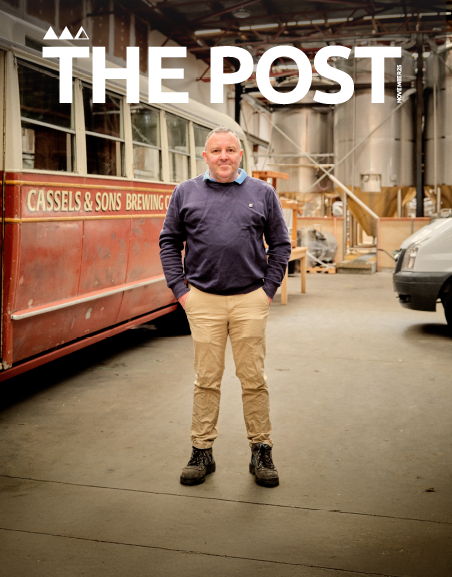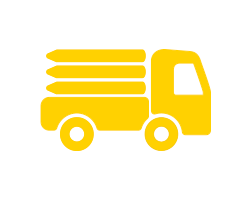Goldpine
Matthew Bolton: A Farm Thriving with Healthy and Happy Goats

Named the largest goat farm in New Zealand, Oete Farm is found in the rolling hill country of Patumāhoe, a small town in the South Auckland region. Owned by Matthew and Sarah Bolton, the business has been operating for seven years, producing high-quality products with a focus on sustainability, innovation and a high standard of animal health.
Matthew and Sarah have come a long way with the growth of their two properties, Oete Farm and Oakdale Farm. Oete Farm was originally a dairy milking station for cows. They have since grown it into what is now one of the leading goat farms in New Zealand, paving the way for the dairy goat industry.
Covering a total of 273 hectares, Oete Farm was their first purchase and since then they’ve expanded their property to include the neighbouring Oakdale Farm, which is now in its second season of production. Both farms are run together as one sole operation and altogether they farm around 5,700 goats for milk production. Their goats are milked through two different milking stations; a 56-bail rotary on Oete Farm and an 80-bail rotary on Oakdale Farm. Matthew and Sarah also acquired 10 hectares of kiwifruit on their farm, using Punchbowl Kiwifruit Services to manage and look after the workload.

Last year, Matthew and Sarah were named Auckland Regional Supreme Winners at the Ballance Farm Environment Awards, gaining recognition that their business is a successful goat farming operation. With 35 members of staff, Matthew and Sarah always acknowledge the team for all of the hard work they do in getting the two farms to where they are today.
“We've got a fantastic crew here and you can't do it without your staff. We have a very dedicated and caring lot. There are some pretty hard and fast rules around treating goats how you’d want to be treated and they're all very on board with that. I think it just makes for more of a positive working environment,” Matthew said.
On the farm, the team like to keep a tight record of things, with all the goats wearing RFID tags to track and monitor their performance. They also set a high standard for animal welfare and have a “Red Cross Area” that goats go to when they’re unwell so that the staff can concentrate more on them.
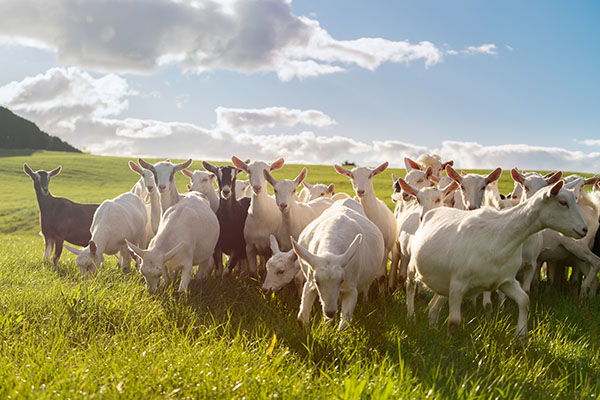
Originally from the Wairarapa region, Matthew worked for 16 years as a dairy farmer. They still own a 2,200 acre sheep and dairy farm which consists of sheep on the hills and dairy on the flats. Matthew tries to visit at least once a month and has a sharemilker that looks after around 1,100 cows.
Before dairy farming, Matthew worked as a sheep and beef farmer. “I was a pretty staunch sheep and beef farmer and there was always some tongue in cheek with the dairy farmers, but it was a way to acquire land, and our fastest route to do that,” Matthew said.
Matthew had itchy feet and wanted to look at other farming opportunities, so he looked into goat farming and the benefits of goat milk. Matthew found that goats were the second animals to be domesticated after dogs 15,000 years ago, and that goat’s milk is very similar to that of human milk, being far better for your digestive system. He reached out to a company called NIG Nutritionals which focuses on bringing healthy and nutrient-rich goat milk products to domestic and global markets. He partnered with NIG Nutritionals to become a supplier of goat milk. Matthew and Sarah reared 2,000 goats to start their goat milk enterprise, relocating to Oete Farm in Patumahoe, which is situated just west of Pukekohe in South Auckland.
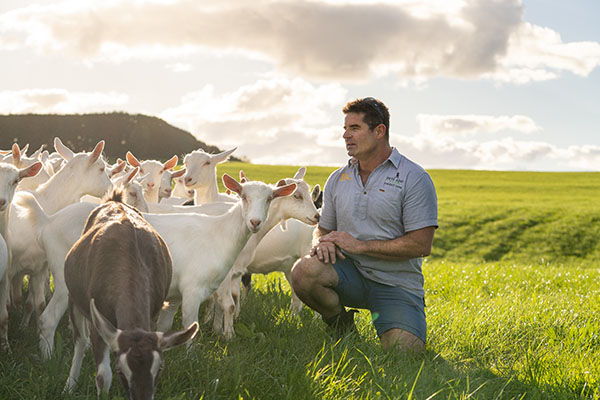
With the partnership going strong, the demand for goat milk continued to increase with NIG Nutritionals asking Matthew if he could supply them with more produce. With a firm agreement in place, specifying them as NIG Nutritionals’ main suppliers, Matthew and Sarah decided to expand their property to include Oakdale Farm. Their product, Before Cow Goat’s Milk, can be found in most Auckland supermarkets and has a magnitude of benefits for skin health, gut health and the environment.
Matthew talks openly about the difference between plant-based milk versus traditional forms of milk. “Although many people think plant sourced milks are a healthy alternative, they generally fall short on the nutritional benefits unless they are heavily fortified with additives to top-up these values.,” Matthew said.
“90% of our milk goes into infant formula and a lot of products are now being made for senior formula as well. It also helps elderly people as they tend to tolerate milk products less and less when they get older, but goat’s milk is ver y different. It’s really good for irritable bowel syndrome, eczema and dermatitis – even ESMA, because of its anti-inflammatory effects.”

It got its name, Before Cow Goat’s Milk, as thous ands of years ago our ancestors used to get their milk from goats. Enriched with vitamin A, A2 protein, and four times more oligosaccharides (sugar molecules that servea healthy gut), goat’s milk is higher in protein, calcium and potassium than regular cow’s milk. Milking goats have less environmental impacts and lower levels of nitrogen and phosphorous leaching. Currently, the two farms are sitting at 11kg of nitrogen per hectare.
An important thing that Matthew and Sarah pride themselves on is that the milk which they produce is coming from really happy goats. “The health and happiness of all of our goats is paramount. To us, our goats aren’t just animals, they are our pets. We are unwavering in our commitment to ensure the very highest standards for them, particularly around our animal welfare and wellbeing policies,” Matthew said.
The goats are even said to boost morale if you’re having a bad day because of their friendly nature and how well they’ve been looked after. On the farm, they house four different breeds of goats: Saanen, Toggenburg, Anglo-Nubian and British Alpine, with the majority of them being Saanen.
“As far as animals go, I think goats are definitely my favourite. But in saying that, I love my cows as well. I think if you love animals, then it's probably just going to appeal anyway,” Matthew said.
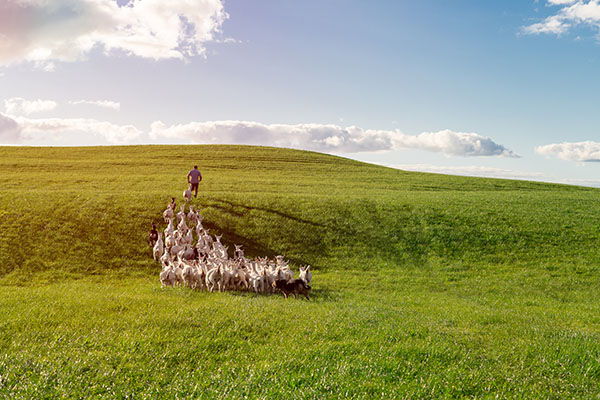
Their busiest time of the year is in kidding season, which happens mid-July. This year, they had around 558 nanny goats give birth to around 870 kids. From birth, the kids get taken to the nursery and taught how to feed properly. Once they start getting older they transition to a grass-fed diet and a larger pen before moving to the indoor sheds where they will mate as yearlings. They use one buck for every 35 goats and no more than that, solely for the health of their animals.
Goats are usually farmed indoors primarily for their health, eliminating the risk of worms. Matthew also talked about how goat hair lacks lanolin, making it hard for their coats to repel water which can make them more vulnerable to pneumonia. For these reasons, their goats spend the majority of their time in the barns. Milking a goat takes around four minutes per animal. Meaning around 80 animals are milked every four minutes on the new rotary and 56 on the old rotary (Goatary). Each goat produces around four litres per day. In the barn, they are also fed through a cut and carry system (also known as a zero-grazing feeding system) to provide the goats with the best quality feed possible. The cut and carry system provides a low cost of production, cutting the grass just above its growing point to enable the grass to resume its photosynthesis process. Matthew and Sarah have found that this method has increased the farm’s grass growing by 30%.
Goats can only eat 3.5kg of dry matter per day so the team reviews the grass every fortnight to ensure that the goats are getting premium feed that is full of macro and micronutrients. Goats are a lot more environmentally friendly on the land and giving them the right food is important as Matthew said that they’re very good at turning their dry matter into milk. They also consume less water than a conventional dairy farm.
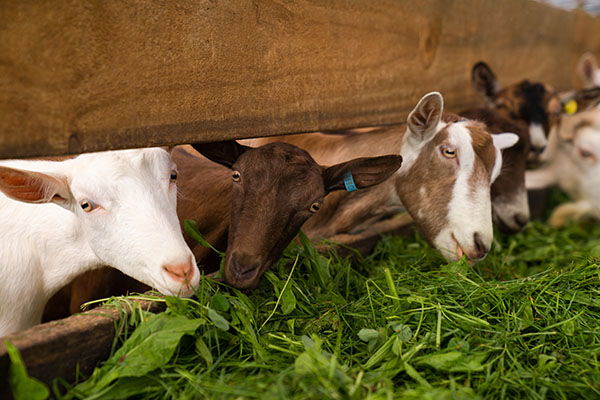
To reduce their carbon emissions, Oete and Oakdale Farm have planted 4.6 hectares of natives which equates to 140,000 trees with 3-metre spacings. In 30 years, the carbon sequestration of all trees will offset 100 tonnes of CO2 equivalent. This has also increased the biodiversity on-farm, including native wood pigeons and tuis.
Oete and Oakdale Farm bring forward a lot of visitors. They have a programme involving council planting for schools where school children from around Auckland come and learn about tree planting and the importance of native species. The children also get the opportunity to play with the goats and learn more about farming as a whole.
Matthew loves to showcase the farming community to children so that they can get a deeper understanding of the processes on farm and how the animals are looked after. It also gives them an insight into the positive things that are happening within the agricultural sector.

Another programme they are involved in is a scheme for school kids which lets them take a goat back to their family home so that they can participate in their local agricultural day. Once finished, they are brought back to the farm. This reinforces a lot of human interaction where the goat is viewed not only as an animal but as a pet too.
Sustainability, animal health and reducing their farm’s environmental footprint are at the heart of what they do. The farm comprises of fresh waterways and have even introduced freshwater crayfish. "They are thriving and now have little babies in there and so these sorts of things are quite cool because that is the real indicator of freshwater,” Matthew said.
Matthew and the team are also conscious of keeping their soils really healthy, keeping the bacterial contents and PH levels up. The nutrients that they produce goes out of their gate every day in the form of goat’s milk, so to keep the milk enriched with calcium, Matthew said they add lime to their pastures. This helps the pastures to thrive, giving the right nutrients to the soil and the plants, and in turn to the goats and their milk.
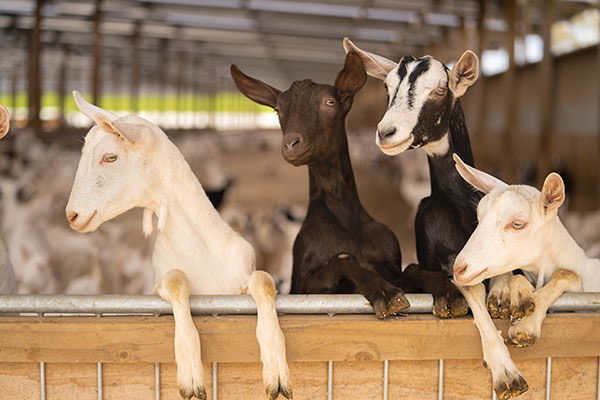
Even though goat farming costs may be higher, the demand for a premium product outweighs that. Creating a successful enterprise and caring for the land is something that Matthew and Sarah want to see passed down to future generations, with the environment in the same, if not better, condition than it was before.
“I think that New Zealand has one of the lowest, if not the lowest, carbon footprints as far as producing some of the best quality products in the world, across the whole farming sector,” Matthew said.
“New Zealand has a responsibility to feed the world and I think that if we can change that mindset and understand that we’re already doing a good job, we can all work together on this. I believe that farmers are on the front line too and I think they need a bit of a break as things are always tough or regulated. We need to change the culture as a whole country and be more kind to the farming community. Farmers keep New Zealand working.”


.jpg)
